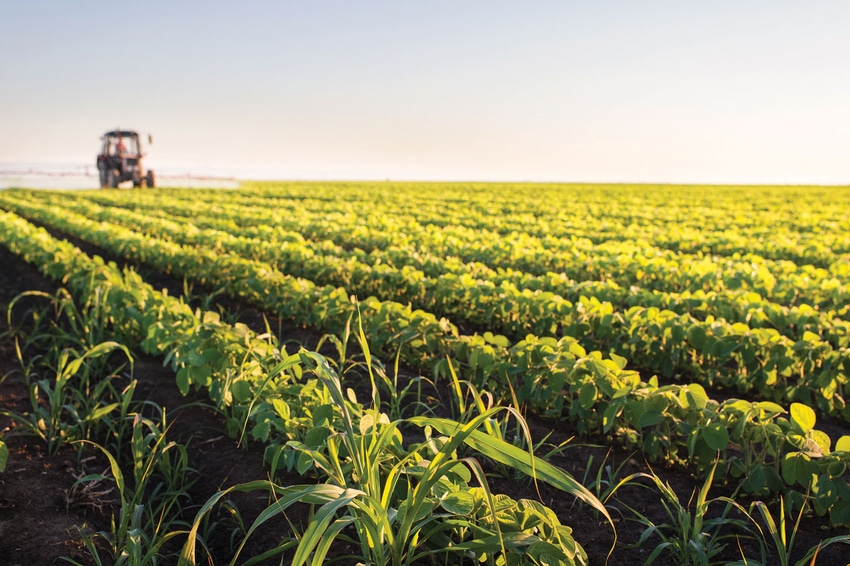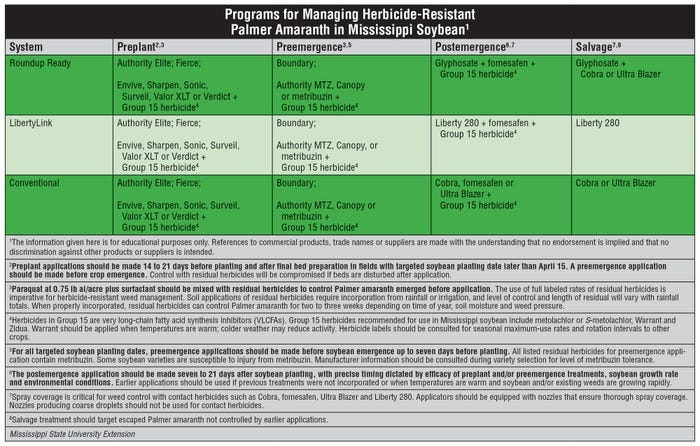October 23, 2020

Controlling problem weeds in cotton, soybeans and other crops has never been easy. Even when farmers were killing 2-foot-tall Palmer amaranth with Roundup, many were thinking, “This is too good to be true.”
Unfortunately, growers can no longer take out Palmer amaranth or pigweed with the label rate of glyphosate. And some are wondering if we’re not going down the same road with the newer dicamba and 2,4-D formulations.
Here are some do's and don’ts from Midsouth weed scientists for dealing with difficult-to-control weeds in cotton and soybeans and, hopefully, keeping resistance to the dicamba and 2,4-D herbicides at bay. They are based on the premise the dicamba formulations, including XtendiMax, will be re-registered for 2021.
1. Preemergence
DO apply a preemergence herbicide at planting. “Just using a quart of Roundup and 22 ounces of XtendiMax in soybeans was actually more effective in 2017 or 2018 than what we’re seeing today,” said Larry Steckel, professor at the University of Tennessee. “We’re seeing more and more pigweed struggle through, and we need to apply an effective residual herbicide upfront to keep the numbers down on what you have to control postemergence.”
Arkansas weed scientists are recommending at least one preemergence application at planting, but they say two pre-herbicides with different modes of action are better. “In soybeans, we’ve shifted to a metribuzin Group 15 herbicide recommendation just because of the PPO resistance that we have in pigweed populations,” said Tom Barber, Extension weed scientist, University of Arkansas. “There are several pre-mixes that include a Group 15 herbicide and metribuzin.”
Some Mississippi farmers are adding residual herbicides in their burndown applications, according to Jason Bond, weed scientist with the Delta Research and Extension Center in Stoneville, Mississippi. “We typically apply burndown herbicides earlier in the spring than they do in Tennessee — theirs usually don’t go out until April or even May. We also tend to do more tillage in the fall with our stale seedbed systems or in the spring than they do in their no-till culture. We don’t think we’re seeing as much dicamba resistance as they are.”
Mississippi State University weed scientists are recommending residual herbicides in both preplant (14 to 21 days before planting) and preemergence herbicide applications that include metribuzin (Sencor) and a Group 15 herbicide (metolachlor, S-metolachlor, Warrant and Zidua).
“We can’t predict what will happen with the registrations,” said Bond. “I’m suggesting that farmers budget for the residual treatments like they were relying on in 2016 and 2017 for 2021. That way, you’ll have that in your budget if we do lose access to the dicamba products.”
2. Overlay
DO overlay residual herbicides. “If you’re planting on April 15, for example, we recommend a preplant residual application 14 to 21 days prior to planting and then another residual at planting,” Bond said. “That would be our version of overlaying residual herbicides. That would be followed by a postemergence residual as well. We’ve been saying that for 10 or 12 years, but it took on new significance when we began seeing PPO-herbicide resistance in 2015 and 2016.”
“In general, we recommend two modes of action,” Barber said. “We have pigweed in Arkansas that has tolerance to Dual and Warrant, which are both Group 15 herbicides — Dual is metolachlor and Warrant is acetochlor. We have some populations in northeast Arkansas that have a little more tolerance to them than the pyroxysulfone in Zidua/Anthem or Outlook. Whether it’s beans or cotton, we want residuals up front. The cotton residuals Brake and Cotoran or Brake plus Diuron or even Cotoran plus Caparol — combinations of multiple products tend to provide us longer and better control vs. just one herbicide.”
Steckel talks frequently about overlaying residual herbicides to achieve good Palmer amaranth control.
Speaking at this year’s online Milan No-Till Field Day, Steckel said: “Here we have Authority MTZ applied preemergence, which did a very good job. Then we came over the top with Anthem Max, Roundup and XtendiMax. We had a residual on top of a residual, and we had very few pigweed to have to deal with when they came up. In this case, the Anthem Max with the XtendiMax did a very good job of taking out small pigweed that happened to get through the Authority MTZ.”
Bob Griffin, a crop consultant based in Jonesboro, Arkansas, compared overlaying residuals to putting shingles on a roof. “I tell folks you don’t lay shingles side by side because you know rain will come through between the shingles. If you overlap them, the rain won’t get through, and the same is true of herbicides.”
3. Tank-mix
DON’T tank-mix glyphosate and the dicamba formulations together when grasses are an issue. Steckel’s research and that of other weed scientists indicates combining the herbicides can reduce the level of grass control in herbicide-tolerant crops.
4. Spray hoods
DO use post-directed sprays and spray hoods if needed. “Given continued reports of Palmer amaranth, prickly sida, barnyardgrass, junglerice and goosegrass escaping glyphosate plus dicamba applications, going back to an “old school” layby is a good idea,” said Steckel. “Post-directed rigs or hooded sprayers are slower than a 100-foot spray boom, but they provide more flexibility on the herbicides that can be used and are often more effective.”
Recommended herbicides include:
A. Direx plus MSMA is an economical treatment that can be used after cotton is 6 inches tall.
B. Clethodim plus MSMA is effective on barnyardgrass, junglerice and goosegrass, but will not control Palmer amaranth.
C. Liberty plus Direx or Caparol or Valor or Zidua or Dual Magnum can be applied under hoods or post-directed and will control horseweed up to 10 inches tall and many broadleaf weeds, including Palmer amaranth and morning glory species.
D. Gramoxone plus Direx, Caparol or Valor can be applied under hooded sprayers on cotton that is at least 12 inches tall.
5. Watch out
DO keep an eye on fields after harvest. “Particularly with corn, if we’re able to get our crop in when we want to, we may have three months between harvest and frost,” Bond said. “That can be good and bad in that it can allow us to control some populations and manage the seed bank in extreme fields that require that. On the other hand, there’s very little we can do with residual herbicides in the fall that will have an impact on Palmer amaranth the following spring.”
Steckel said one approach would be mowing to prevent Palmer amaranth and grasses from going to seed after harvest.
“We have done work with Gramoxone after the corn harvest is over,” Steckel said. “All that has helped a good bit on reducing the seed bank. I’ve been pleading with people in cotton to get their hoods back out. Paraquat-Valor under a hood is money on pigweeds. Direx-MSMA is pretty cheap directed under the cotton. We have to get more diversity in our weed management.”
6. Cover crops
DO plant a fall cover crop. “From 20% to 25% of our acres are being planted to a cover crop,” Steckel said. “Last year, the fall weather wasn’t good for us. But one of the calls I get every year is ‘Will my defoliant hurt my cover crop that I just sowed in this cotton?’ Research by Mathew Wiggins and Garrett Montgomery, graduate students at UT, showed a good cover crop could reduce the amount of Palmer pigweed that has to be controlled with a postemergence herbicide by 50%. If you get a good pre in there, it’s even more.
“A grass legume and a vetch with wheat or cereal rye have been a good combination for us. I’ve settled on wheat because almost everyone has wheat in the bin. The USDA Natural Resources Conservation Service blend is a little bit of this and a little bit of that and not enough of anything to provide good weed control.”
7. Clean up
DON’T let weeds grow up around disks or other tillage tools in the equipment yard. “I realize nobody wants to hear this, but Palmer amaranth and other problem weeds that are larger than 6 inches tall will not be easily controlled with a single herbicide application,” said Eric Prostko, weed scientist with the University of Georgia, who writes extensively about herbicide issues. “Consequently, tillage with extreme prejudice must be seriously considered when Goliath-like plants are present. Do not be afraid to bury the disk!”
8. Research
DO ask for research into commercial uses for Palmer amaranth. A plant that can grow as fast as it does and produces 400,000 to 500,000 seeds per plant has to be good for something.

About the Author(s)
You May Also Like






